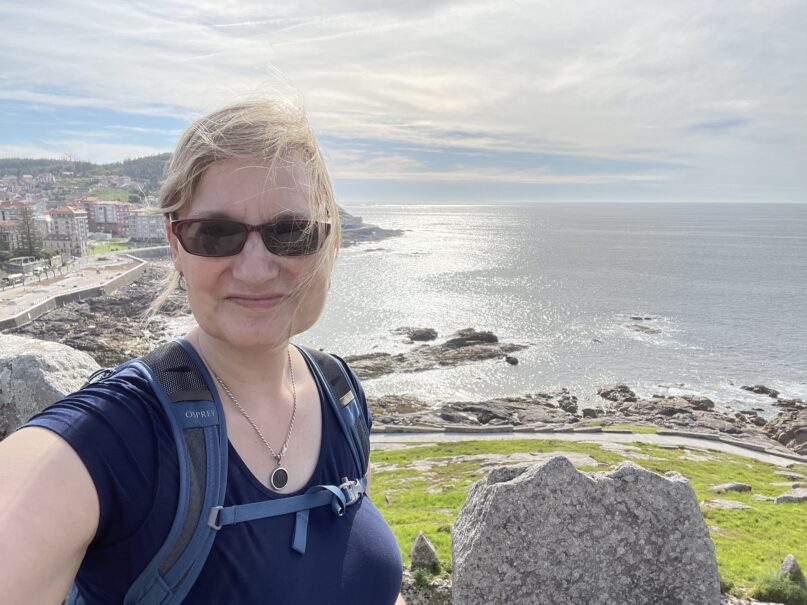(RNS) — It’s been nearly two months now since I returned from walking part of the Camino de Santiago in Spain, but for whatever reason I’ve resisted writing about the experience until now. I’m still processing what a remarkable trip it was — and in that sense, the pilgrimage continues.
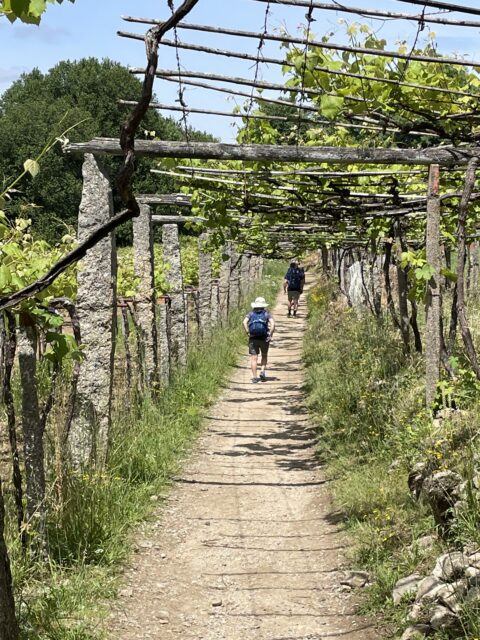
The Camino Portugués, May 2023. Photo by Jana Riess
First, let me get the basics out of the way: In May I walked the last 128 kilometers of the Camino Portugués, alongside one of my closest friends. That’s enough distance to receive your “compostela” — the fancy Latin certificate you can apply for at the end of the journey if you’ve walked more than 100 kilometers. Or, as I learned on the way, if you’ve biked or ridden it on horseback for twice that distance. We actually did see a few people on horseback, which was a beautiful throwback to the days of old. Pilgrims have been journeying along “the Camino”—which is still called that, singular, even though there are multiple routes that all wind up in Santiago — for around a thousand years, and some portions of it feel alive with the history of hundreds of thousands of feet.
In 2011, just over 183,000 pilgrims received a compostela, but last year it was the highest-ever, at over 438,000. Someone asked me recently whether the Camino isn’t just a dressed-up tourist experience now as its popularity has increased so much in recent years.
I don’t think it is, or at least it wasn’t for me. But I also don’t think it’s fair to cast a clear and neat dividing line between pilgrim and tourist.
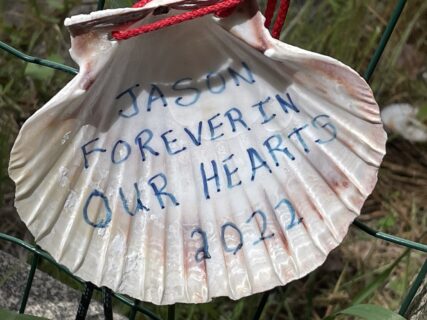
A pilgrim’s memorial to a loved one along the Camino, May 2023. Photo by Jana Riess
I had some very meaningful spiritual experiences on the Camino, including one simple but transformative encounter in a church on one of the last few days of walking. I had stopped to light candles for a friend who is experiencing a terrible illness. I must have looked emotional — I thought I was keeping things totally under control, but I have no poker face to speak of.
When I was about to leave, the front desk volunteer asked me if I was “triste” (sad). Her face was full of compassion.
And that’s when I began to cry in earnest, spilling out my anxieties in my halting Spanish.
“La vida es dura,” the woman said. Life is hard.
Now, there are all kinds of ways that sentence can come out of the mouth of a stranger, ways that would be hurtful rather than healing. It could have been a callous indifference, a nudge to simply move on, to get over it. This was not that. The volunteer, sitting at her table at the front of the church, felt the pain of the world in that moment. She blew me kisses as we left, a universal statement of love that transcends language barriers.
So yes, the Camino was filled with spiritual moments, mostly tied up in human stories.
There was the Irish group we encountered, in which a middle-aged man was carrying two large backpacks, his own and that of an elderly man I wrongly assumed was his father. No, it was actually his longtime neighbor back in Ireland, and they’d walked portions of the Camino together many times. The younger man was walking at half-pace, matching his steps to his older friend’s and hauling his gear for him. But they were telling stories and singing songs along the way, filled with joy. (Did I mention they were Irish?)
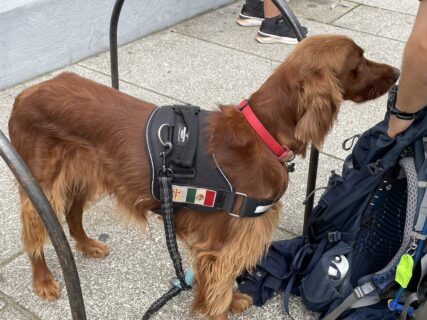
This dog did the whole Camino Francés, May 2023. Photo by Jana Riess
Then there was the dog from Mexico. At the very end of our journey when we reached Santiago, we met a man who had traveled along the whole Camino Francés, one of the oldest and longest routes, with his dog. If I understood his story correctly, at one point she injured her leg and wasn’t able to walk anymore, so he bought a wagon and pulled her along until she was healthy again. They made it, together, all the way across Spain.
Everyone on the Camino had a story, a reason they had come. I was moved and fascinated by the things pilgrims had left behind in makeshift cairns and shrines—a rock from home, a seashell, a photo of a deceased loved one in whose memory they were walking.
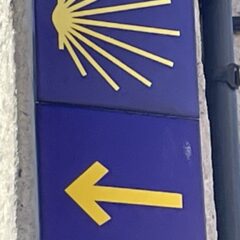
A way marker on the Camino Portugués, May 2023. Photo by Jana Riess
So yes, the Camino was deeply spiritual. I certainly thought about God and creation more than I do in my daily life, and I prayed more, even if the prayer was “Oh Lord, please please tell me this is the last hill today.”
On the other hand, I wasn’t walking the Camino to do penance for sin, like the pilgrims of centuries ago, or even to obtain an answer to some deep and pressing spiritual question. As someone who loves to travel, admittedly, there was a “bucket list“ aspect of walking the Camino for me, at least this first time. And I reveled in the tourist experiences that did come our way: delicious churros with chocolate, and the beautiful scenery on the west coast of Spain.
It’s a false and unhelpful dichotomy to claim that the pilgrim is focused on the spiritual, while the tourist is concentrating on the merely physical — the scenery, the food, the weather. In fact, rarely have I been more conscious of physical realities, like the limitations of my body, or how quickly a day can turn sour when the weather is not cooperating. (Happily for us, we only had two days that were even partly rainy.) Rather, one thing I learned is that every day I’m privileged to be on the planet, I am both a pilgrim and a tourist — alive to the things of God, but also enjoying the things of this world.

Finally arriving, exhausted but joyful, at the Cathedral of St. James in Santiago. May 2023. Photo courtesy of Jana Riess
This is not going to be my last Camino. If my body and my checkbook allow it, I would love to do it again, possibly along the classic Camino Francés. I’ve learned some practical tips from this short taste of the Camino, including several things I packed but had no use for, and other items that I would’ve definitely liked to have with me.
Next time, I expect that I will continue sending my bag ahead each day, because that was a decision I never once regretted even for a moment. To have the freedom to not carry everything on my back was amazing. But I hope that next time I will take each day more as it comes, rather than planning out the entire itinerary in advance. There’s a saying on the Camino that “the Camino provides.” Everything I needed was there. I just had to trust this was true.
Related content:
“The Way,” Emilio Estevez’s film about the Camino, returns to theaters
“I’ll push you”: Friends, one in a wheelchair, document their Spanish pilgrimage
